Amplitude Dependent Internal Friction in Strained Magnesium Alloys of AZ Series
Abstract
1. Introduction
2. Materials and Methods
2.1. Microstructure of Alloys
2.2. Internal Friction Measurements
3. Results
4. Discussion
- The critical strain, εcr, after the initial rapid decrease in the region of small predeformation steps, again increased with the increasing maximum strain amplitude; and
- A saturation region of the εcr vs % of predeformation was observed for the AZ31 and AZ61 alloys.
5. Conclusions
Author Contributions
Funding
Conflicts of Interest
References
- Polmear, I.; StJohn, D.; Nie, J.F.; Qian, M. Light Alloys, 5th ed.; Butterworth-Heinemann: Waltham, MA, USA, 2017; pp. 109–156. [Google Scholar]
- Luo, A.A.; Sachdev, A.K. Advances in Wrought Magnesium Alloys, 1st ed.; Bettles, C., Barnett, M., Eds.; Woodhead Publishing: London, UK, 2012; pp. 393–426. [Google Scholar]
- Luo, A.; Pekguleryuz, M.O. Cast magnesium alloys for elevated temperature applications. J. Mater. Sci. 1994, 29, 5259–5271. [Google Scholar] [CrossRef]
- Bettles, C.; Gibson, M. Current wrought magnesium alloys: Strengths and weaknesses. JOM 2005, 57, 46–49. [Google Scholar] [CrossRef]
- Yang, Z.; Li, J.P.; Zhang, J.X.; Lorimer, G.W.; Robson, J. Review on research and development of magnesium alloys. Acta Metall. Sin. (Engl. Lett.) 2008, 21, 313–328. [Google Scholar] [CrossRef]
- Witte, F.; Fischer, J.; Nellesen, J.; Crostack, H.-A.; Kaese, V.; Pisch, A.; Beckmann, F.; Windhagen, H. In vitro and in vivo corrosion measurements of magnesium alloys. Biomaterials 2006, 27, 1013–1018. [Google Scholar] [CrossRef] [PubMed]
- Doležal, P.; Zapletal, J.; Fintová, S.; Trojanová, Z.; Greger, M.; Roupcová, P.; Podrábský, T. Influence of processing techniques on microstructure and mechanical properties of a biodegradable Mg-3Zn-2Ca alloy. Materials 2016, 9, 880. [Google Scholar] [CrossRef]
- Zhang, S.X.; Zhang, X.N.; Zhao, C.L.; Li, J.N.; Song, Y.; Xie, C.Y.; Tao, H.R.; Zhang, Y.; He, Y.H.; Jiang, Y.; et al. Research on an Mg-Zn alloy as a degradable biomaterial. Acta Biomater. 2010, 6, 626–640. [Google Scholar] [CrossRef]
- Mordike, B.L.; Ebert, T. Magnesium: Properties—Applications—Potential. Mater. Sci. Eng. A Struct. Mater. Prop. Microstruct. Process. 2001, 302, 37–45. [Google Scholar] [CrossRef]
- Wan, D.; Wang, J.; Wang, G.; Lin, L.; Feng, Z.; Yang, G. Precipitation and responding damping behavior of heat-treated AZ31 magnesium alloy. Acta Metall. Sin. (Engl. Lett.) 2009, 22, 1–6. [Google Scholar] [CrossRef]
- Zhang, Z.; Zeng, X.; Ding, W. The influence of heat treatment on damping response of AZ91D magnesium alloy. Mater. Sci. Eng. A Struct. Mater. Prop. Microstruct. Process. 2005, 392, 150–155. [Google Scholar] [CrossRef]
- Celotto, S. TEM study of continuous precipitation in Mg-9 wt% Al-1 wt% Zn alloy. Acta Mater. 2000, 48, 1775–1787. [Google Scholar] [CrossRef]
- González-Martínez, R.; Göken, J.; Letzig, D.; Steinhoff, K.; Kainer, K.U. Influence of aging on damping of the magnesium-aluminium-zinc series. J. Alloys Compd. 2007, 437, 127–132. [Google Scholar] [CrossRef]
- Mato, R.R.A.M.; Mufuruki, T.S. Noise pollution associated with the operation of the Dar es Salaam International Airport. Transp. Res. Part D Transp. Environ. 1999, 4, 81–89. [Google Scholar] [CrossRef]
- Ritchie, I.G.; Pan, Z.L.; Sprungmann, K.W.; Schmidt, H.K.; Dutton, R. High damping alloys—The metallurgist’s cure for unwanted vibrations. Can. Metall. Q. 1987, 26, 239–250. [Google Scholar] [CrossRef]
- Granato, A.V.; Lücke, K. Theory of mechanical damping due to dislocations. J. Appl. Phys. 1956, 27, 583–593. [Google Scholar] [CrossRef]
- Granato, A.V.; Lücke, K. Application of dislocation theory to internal friction phenomena at high frequencies. J. Appl. Phys. 1956, 27, 789–805. [Google Scholar] [CrossRef]
- Granato, A.V. Internal studies in dislocation motion. In Dislocation Dynamics; Rosenfield, A.R., Hahn, G.T., Bement, A.L., Jr., Jaffee, R.I., Eds.; McGraw-Hill: New York, NY, USA, 1968; p. 117. [Google Scholar]
- Granato, A.V.; Lücke, K. Temperature dependence of amplitude-dependent dislocation damping. J. Appl. Phys. 1981, 52, 7136–7142. [Google Scholar] [CrossRef]
- Teutonico, L.J.; Granato, A.V.; Lücke, K. Theory of the thermal breakaway of a pinned dislocation line with application to damping phenomena. J. Appl. Phys. 1964, 35, 220–234. [Google Scholar] [CrossRef]
- Marchesoni, F.; Segoloni, D. The string model of dislocation damping revisited. Acta Phys. Pol. Ser. B 1993, 24, 865–889. [Google Scholar]
- Gremaud, G.; Kustov, S. Non-linear elasticity due to dislocation-solute atom interactions in solid solutions. J. Alloys Compd. 2000, 310, 85–90. [Google Scholar] [CrossRef]
- Gremaud, G. Dislocation-point defect interaction. In Mechanical Spectroscopy; Schaller, R., Fantozzi, G., Graemaud, G., Eds.; Trans Tech Publications LTD: Uetikon-Zuerich, Switzerland, 2001; Volume 366–368, pp. 178–246. [Google Scholar]
- D´Anna, G.; Benoit, W.; Vinokur, V.M. Internal friction and dislocation collective pinning in disordered quenched solid solutions. J. Appl. Phys. 1997, 82, 5983–5990. [Google Scholar] [CrossRef]
- González-Martínez, R.; Göken, J.; Letzig, D.; Timmerberg, J.; Steinhoff, K.; Kainer, K.U. Influence of heat treatment on damping behaviour of the magnesium wrought alloy AZ61. Acta Metall. Sin. (Engl. Lett.) 2007, 20, 235–240. [Google Scholar] [CrossRef]
- Göken, J.; Riehemann, W. Damping behaviour of AZ91 magnesium alloy with cracks. Mater. Sci. Eng. A 2004, 370, 417–421. [Google Scholar] [CrossRef]
- Trojanová, Z.; Mielczarek, A.; Riehemann, W.; Lukáč, P. Cyclic bending and the damping behaviour of short fibre-reinforced magnesium alloy AZ91. Compos. Sci. Technol. 2006, 66, 585–590. [Google Scholar] [CrossRef]
- Jun, J.-H. Damping behavior of Mg-Zn-Al casting alloys. Mater. Sci. Eng. A 2016, 665, 86–89. [Google Scholar] [CrossRef]
- Trojanová, Z.; Lukáč, P.; Džugan, J.; Halmešová, K. Amplitude dependent internal friction in a Mg-Al-Zn alloy studied after thermal and mechanical treatment. Metals 2017, 7, 433. [Google Scholar] [CrossRef]
- Hurtalová, L.; Tillová, E.; Chalupová, M.; Belan, J.; Vaško, A. Microstructure control of secondary A 231 cast alloy used in automotive industry. Manuf. Technol. J. Sci. Res. Prod. 2014, 14, 326–333. [Google Scholar]
- Belan, J.; Kuchariková, L.; Vaško, A.; Tillová, E. Applied heat treatment and its influence on IN 718 alloy fatigue life. Manuf. Technol. J. Sci. Res. Prod. 2016, 16, 865–870. [Google Scholar]
- Palček, P.; Porubčan, J.; Blažek, D.; Trojanová, Z. Internal friction in commercial aluminium alloy AW-2007. Procedia Eng. 2011, 10, 1226–1231. [Google Scholar] [CrossRef][Green Version]
- Trojanová, Z.; Chmelík, F.; Lukáč, P.; Rudajevová, A. Changes in the microstructure of QE22 composites estimated by non-destructive methods. J. Alloys Compd. 2002, 339, 327–334. [Google Scholar] [CrossRef]
- Trojanová, Z.; Lukáč, P.; Chmelík, F.; Riehemann, W. Microstructural changes in ZE41 composite estimated by acoustic measurements. J. Alloys Compd. 2003, 355, 113–119. [Google Scholar] [CrossRef]
- Trojanová, Z.; Drozd, Z.; Lukáč, P.; Minárik, P.; Džugan, J.; Halmešová, K. Amplitude-dependent internal friction in AZ31 alloy sheets submitted to accumulative roll bonding. Low Temp. Phys. 2018, 44, 1233–1240. [Google Scholar] [CrossRef]
- Blažek, D.; Palček, P.; Trojanová, Z.; Porubčan, J. Amplitude dependent internal friction of magnesium alloy AZ31 at room temperature. Solid State Phenom. 2012, 184, 179–184. [Google Scholar] [CrossRef]
- Kê, T.S. Low frequency internal-friction peaks as a function of strain amplitude in cold-worked dilute aluminium alloys. J. Phys. Colloq. 1981, 42, 307–312. [Google Scholar] [CrossRef]
- Kê, T.S. Anomalous internal friction peaks as function of strain amplitude. J. Phys. Colloq. 1985, 46, 267–275. [Google Scholar] [CrossRef]
- Cáceres, C.H.; Griffiths, J.R.; Davidson, C.J.; Newton, C.L. Effects of solidification rate and ageing on the microstructure and mechanical properties of AZ91 alloy. Mater. Sci. Eng. A 2002, 325, 344–355. [Google Scholar] [CrossRef]
- Corby, C.; Cáceres, C.H.; Lukáč, P. Serrated flow in magnesium alloy AZ91. Mater. Sci. Eng. A 2004, 387–389, 22–24. [Google Scholar] [CrossRef]
- Trojanová, Z.; Cáceres, C.H. On the strain to the onset of serrated flow in a magnesium alloy. Scr. Mater. 2007, 56, 793–796. [Google Scholar] [CrossRef]
- Trojanová, Z.; Cáceres, C.H.; Lukáč, P.; Čížek, L. Serrated flow in AZ91 magnesium alloy in tension and compression. Kov. Mater. 2008, 46, 249–256. [Google Scholar]
- Watanabe, H.; Sasakura, Y.; Ikeo, N.; Mukai, T. Effect of deformation twins on damping capacity in extruded pure magnesium. J. Alloys Compd. 2015, 626, 60–64. [Google Scholar] [CrossRef]
- Lebedev, A.B.; Ivanov, V.I. The temperature dependences of internal friction and yield stress in Al alloys. Mater. Sci. Forum 1993, 119–121, 245–250. [Google Scholar] [CrossRef]
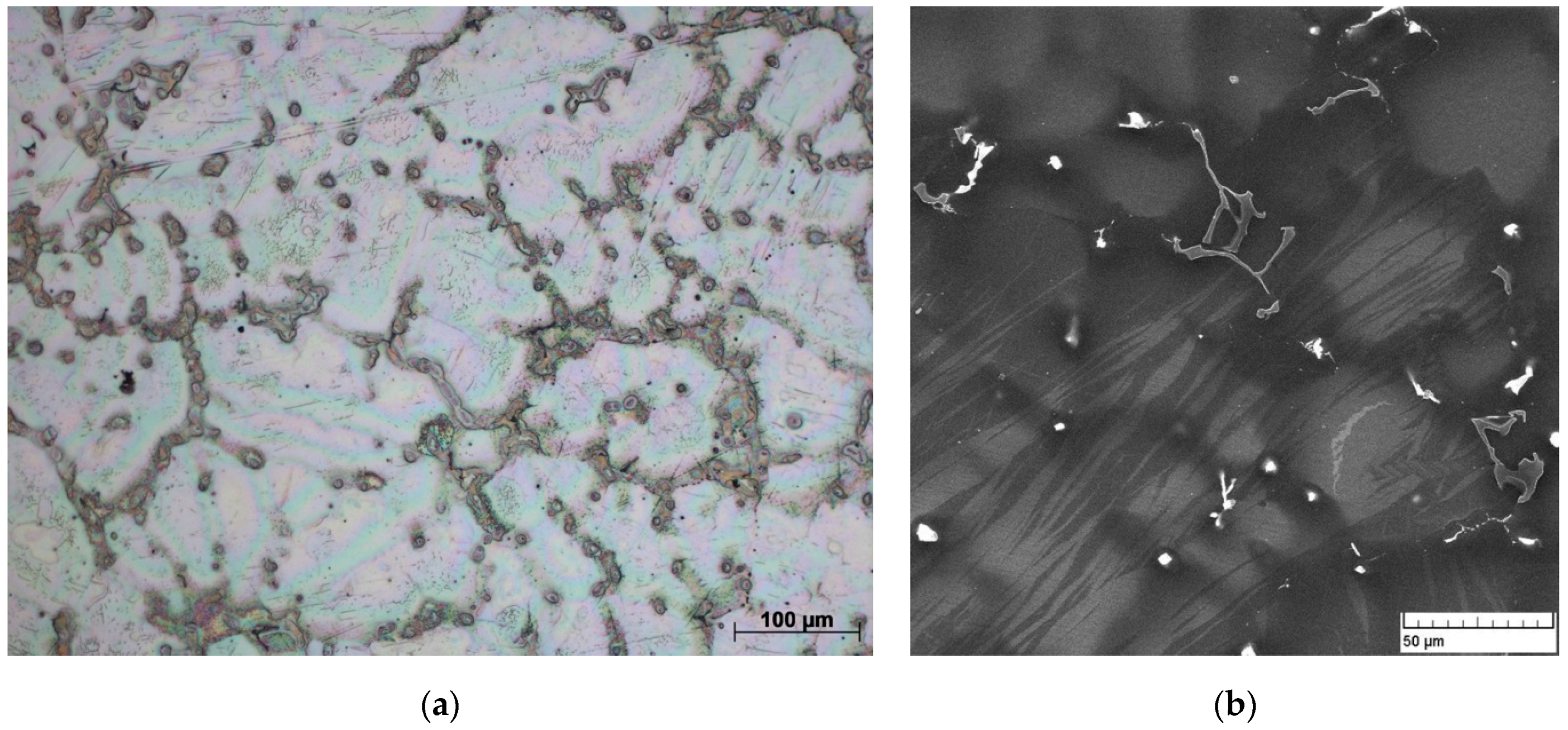
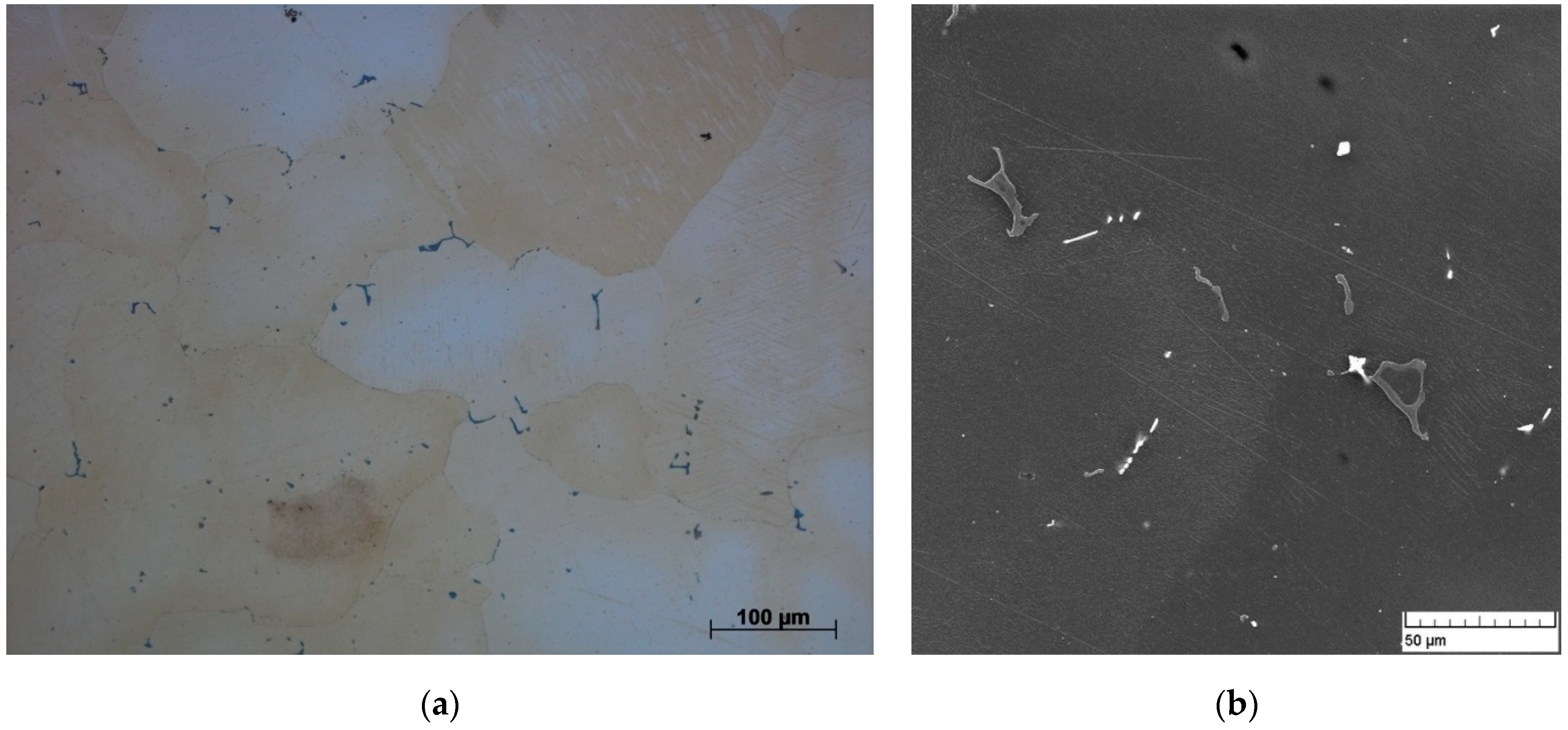
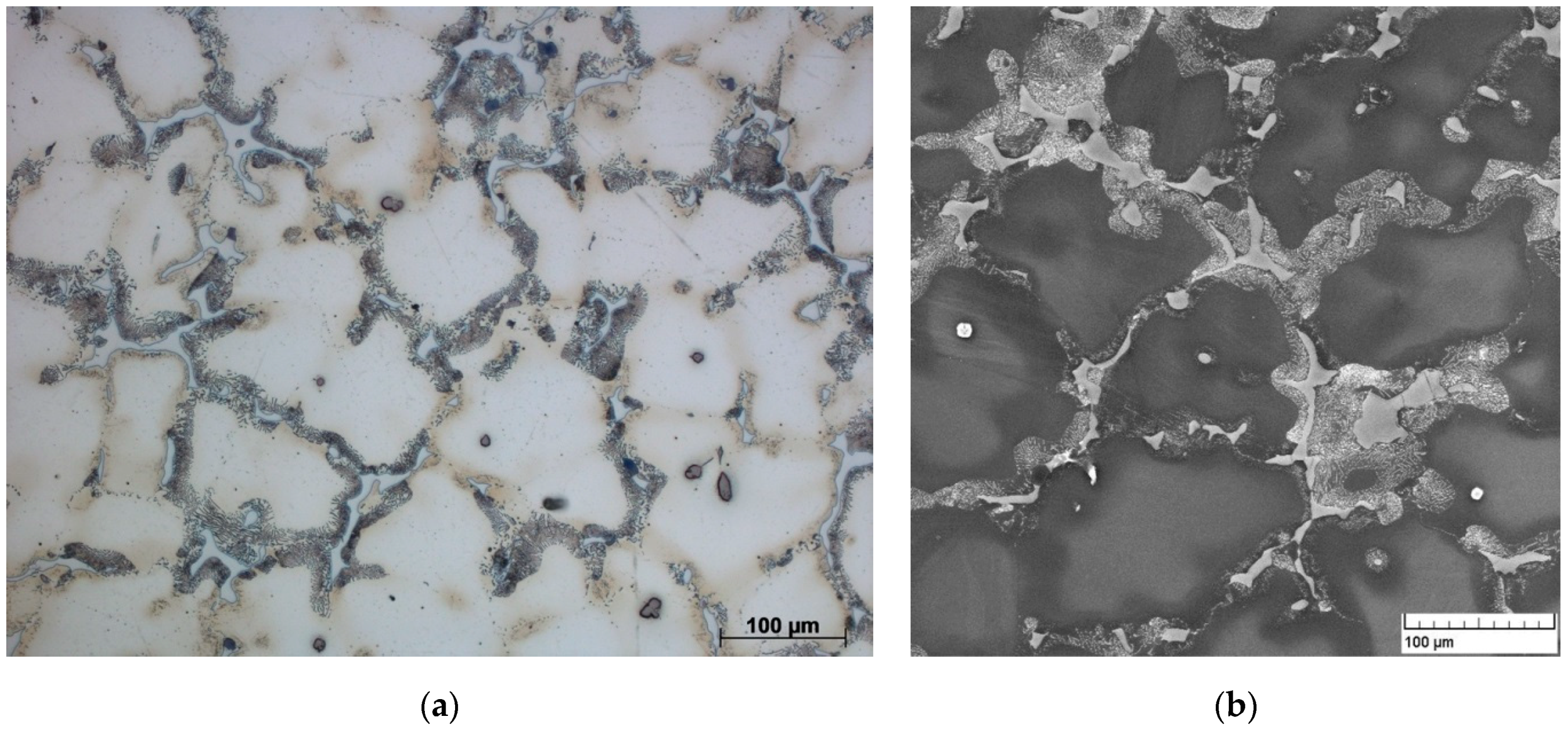
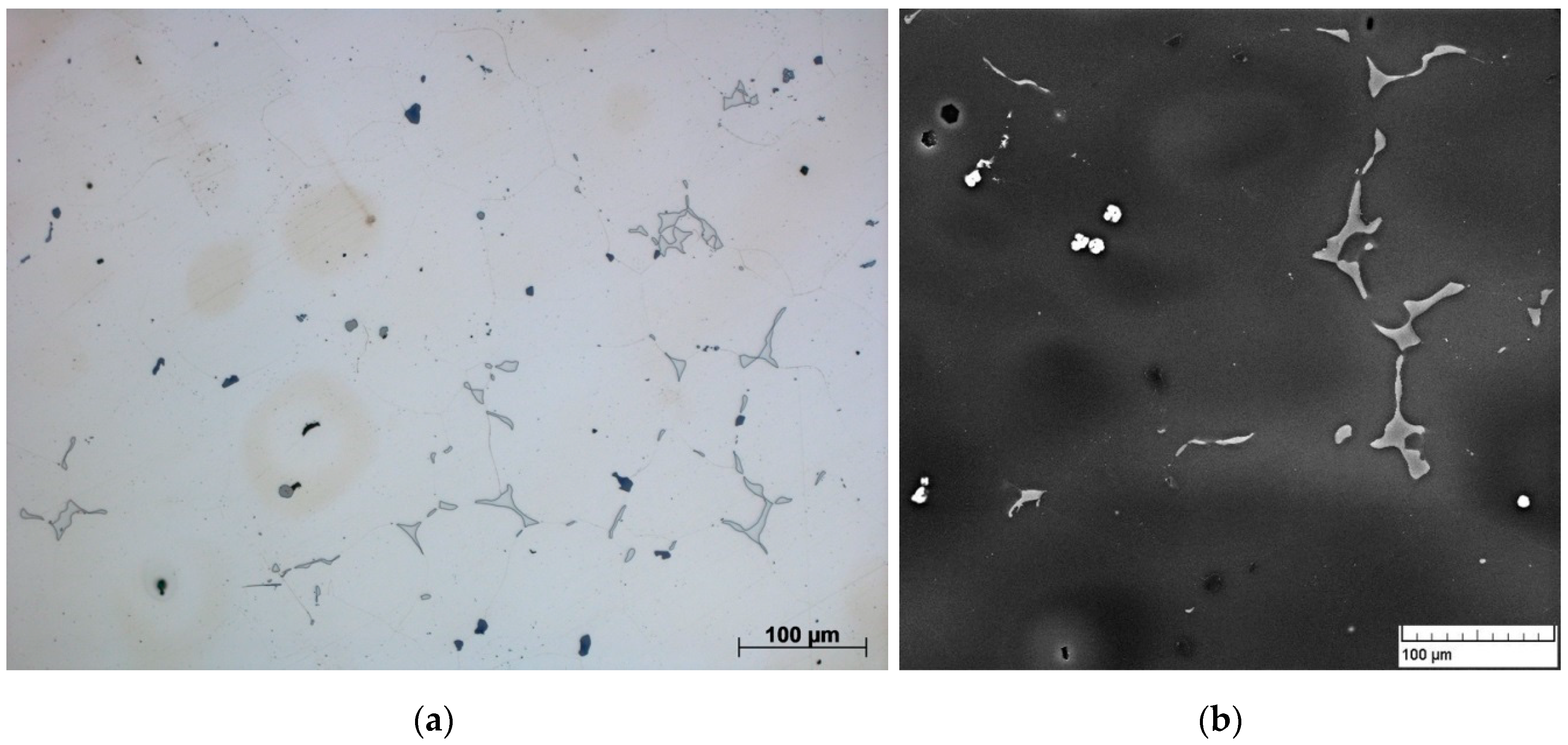

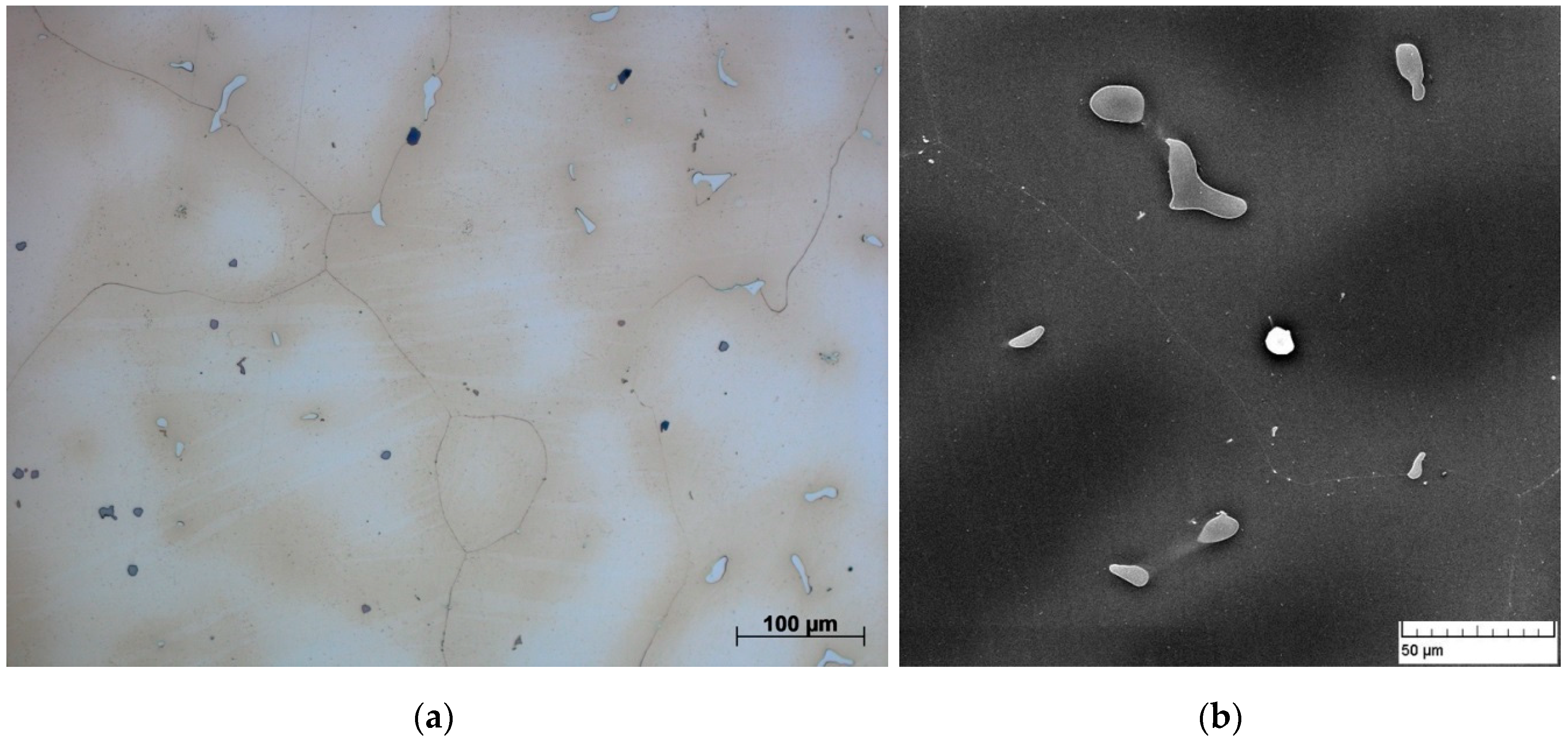


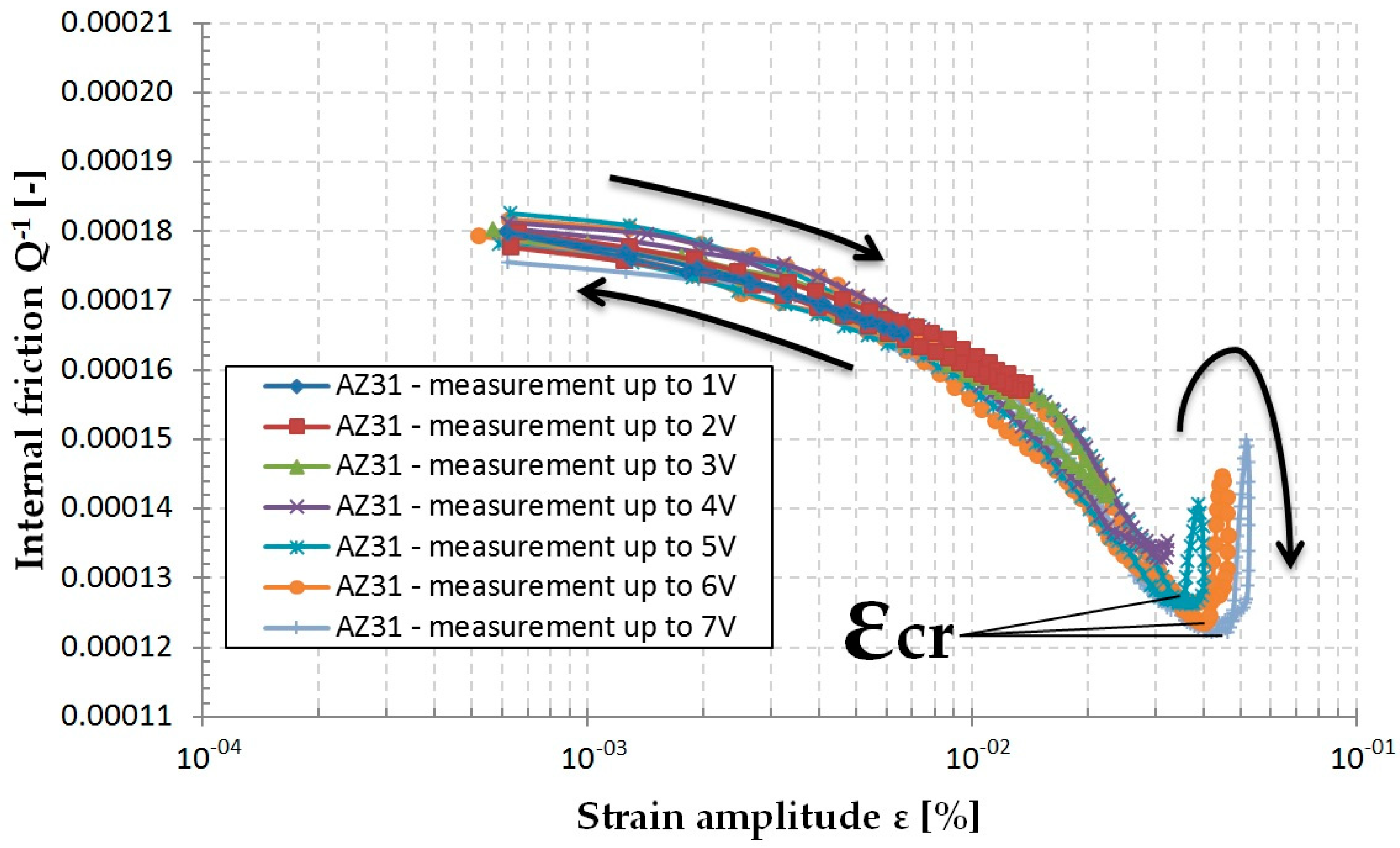
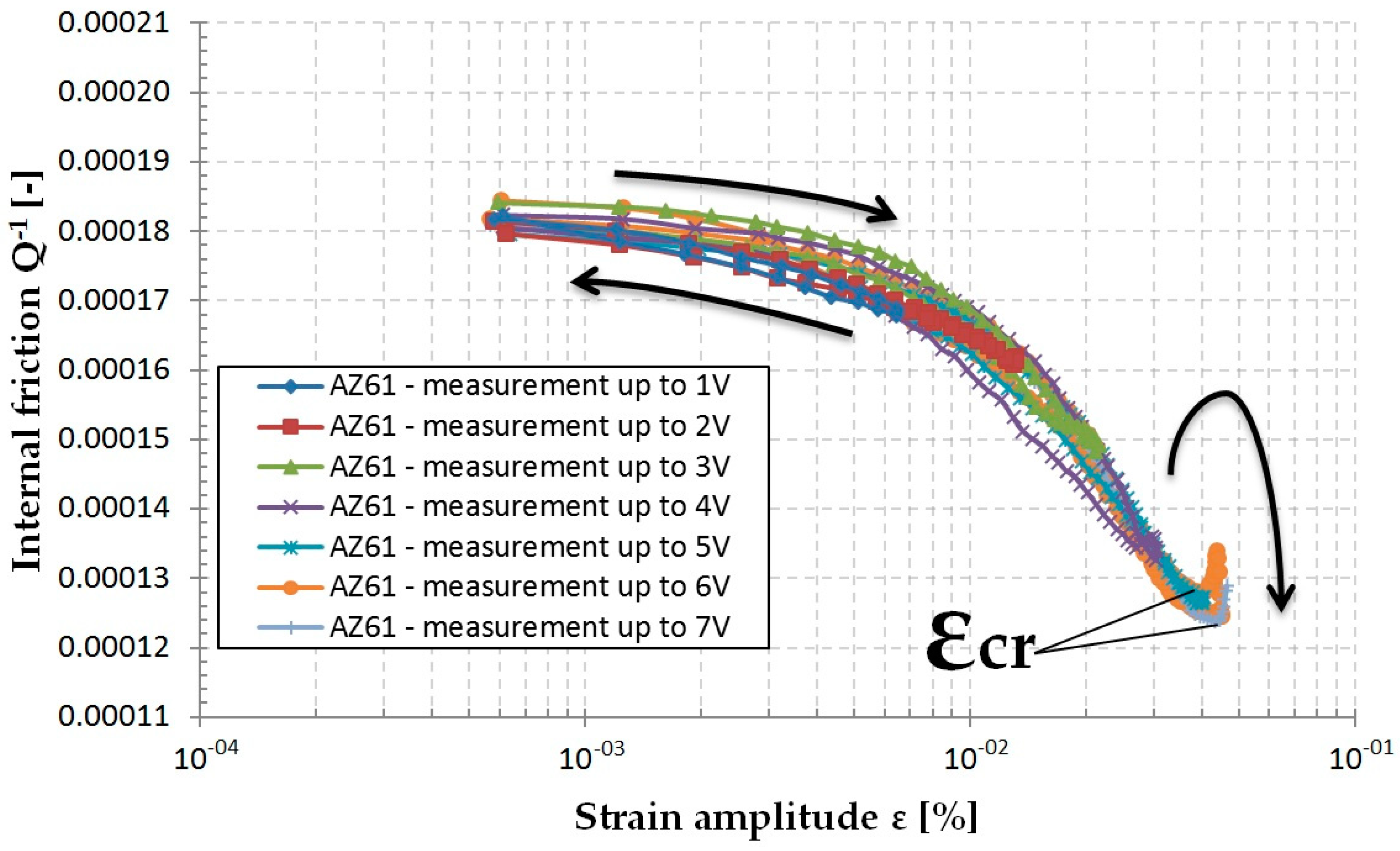
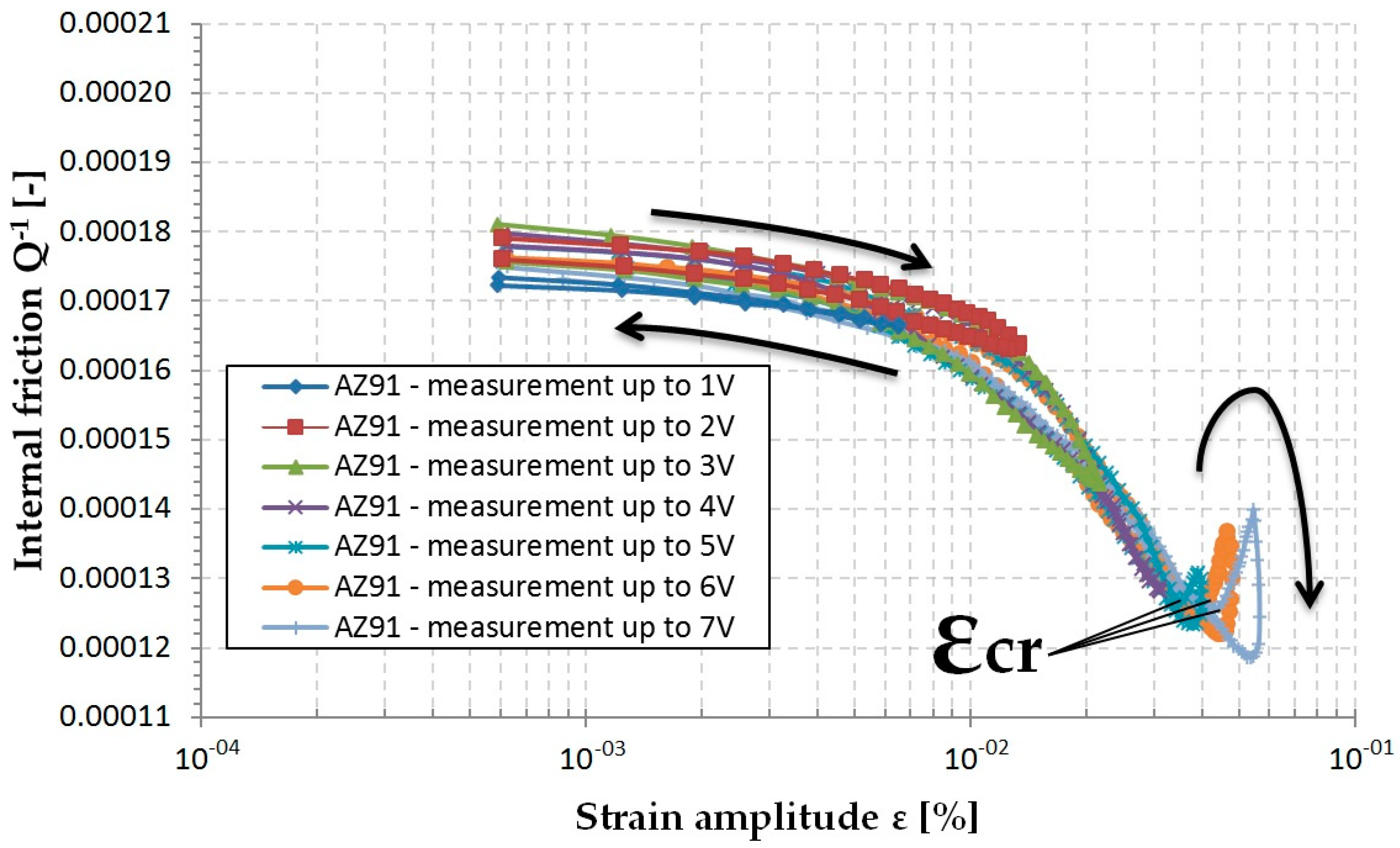
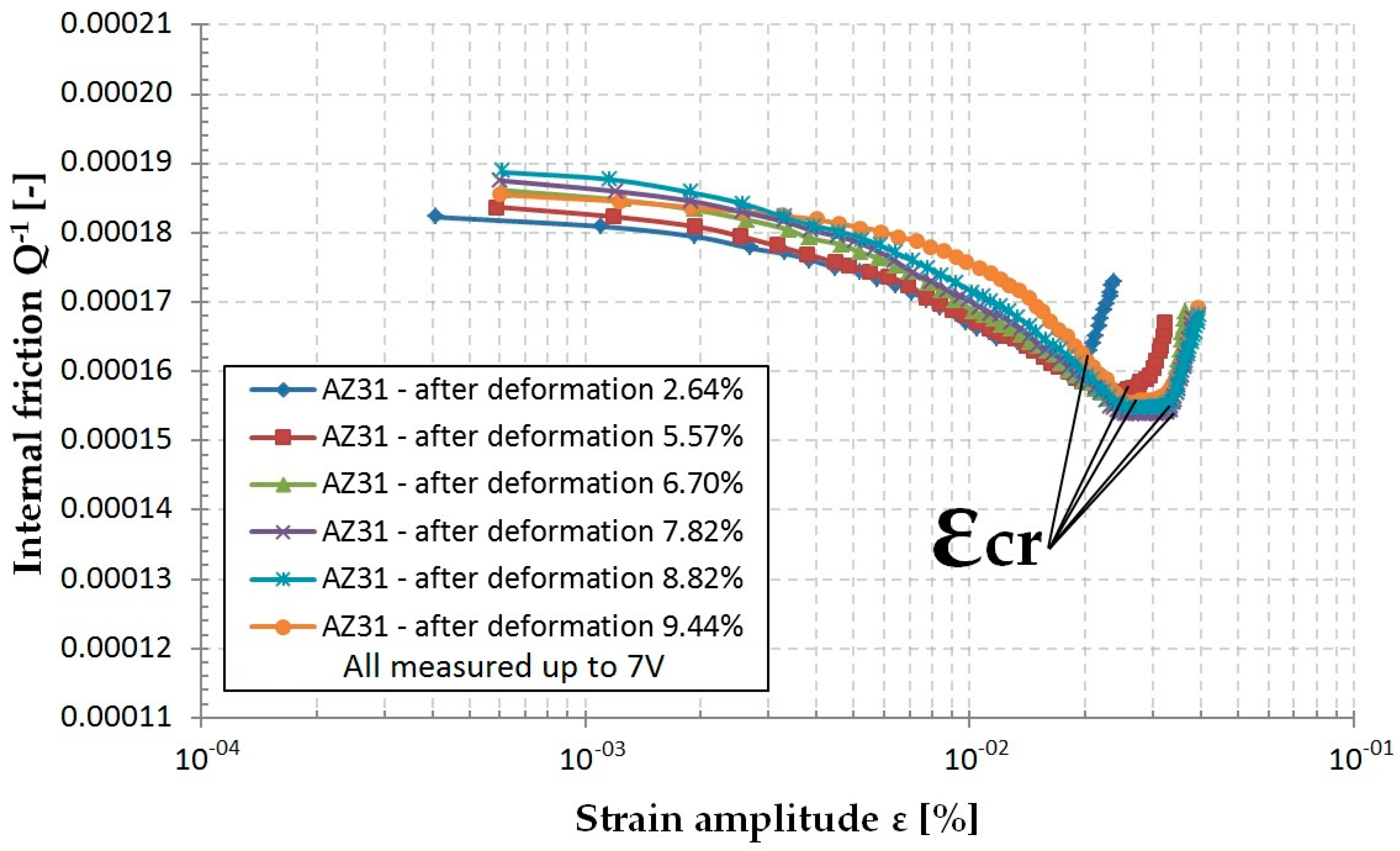
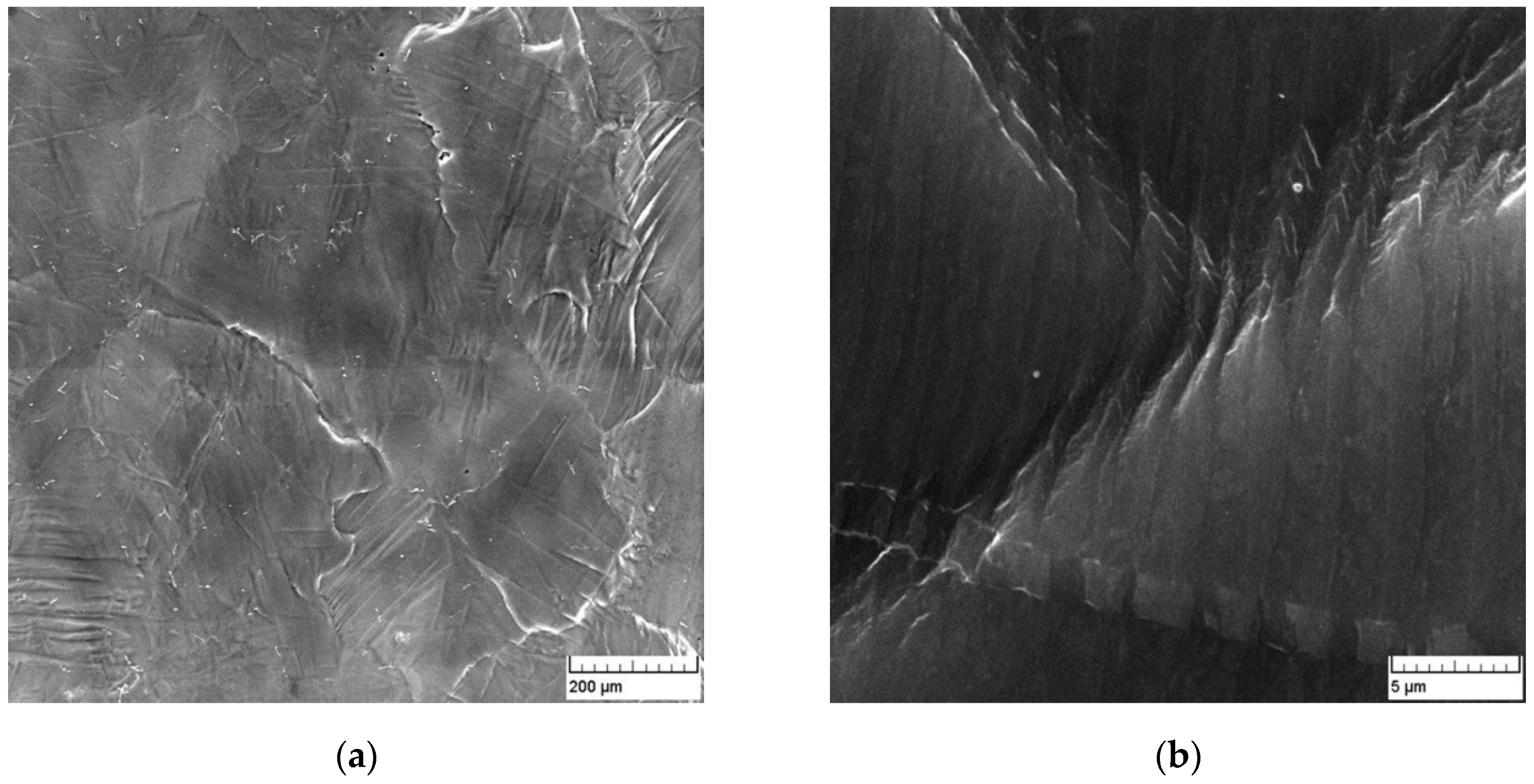
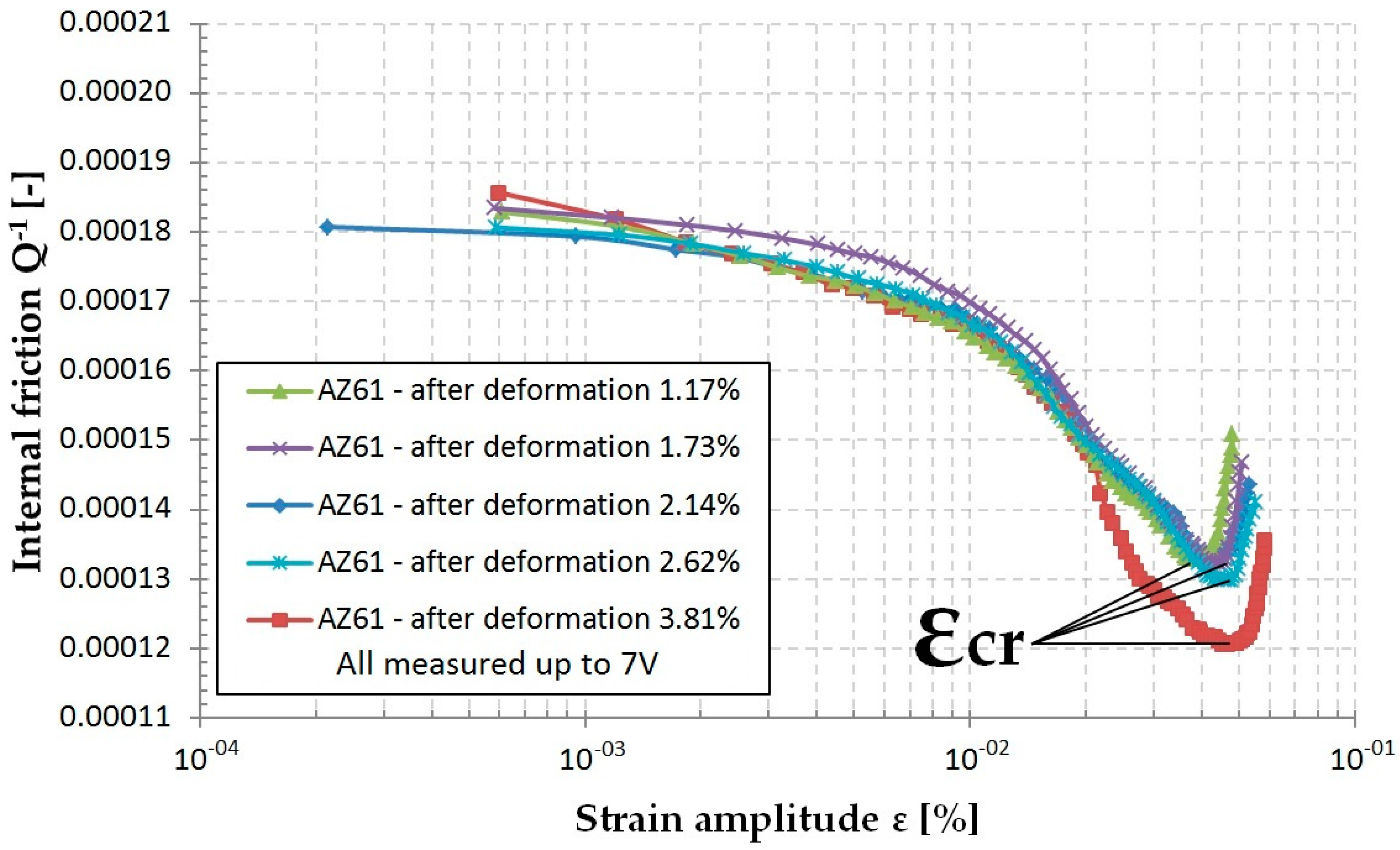
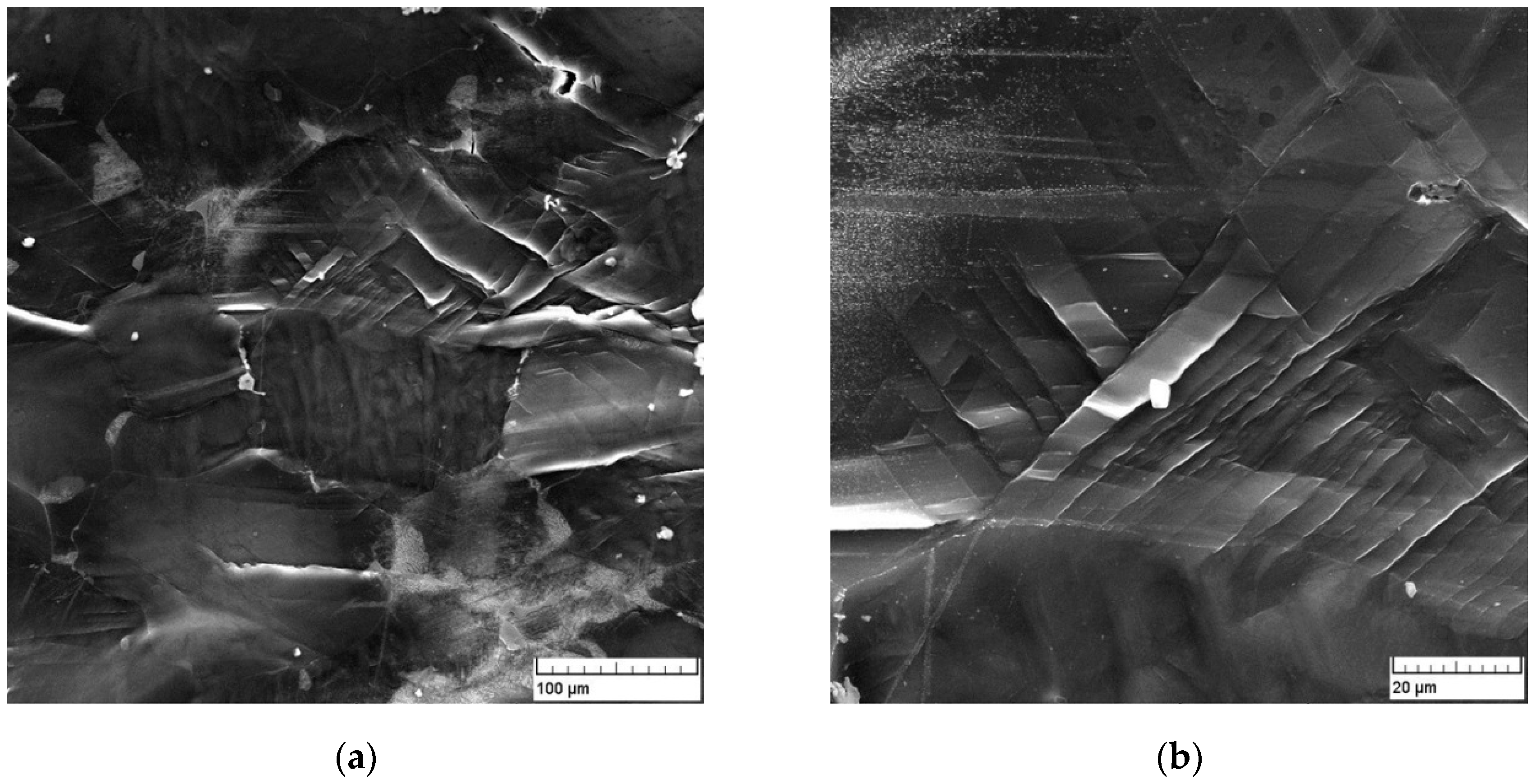
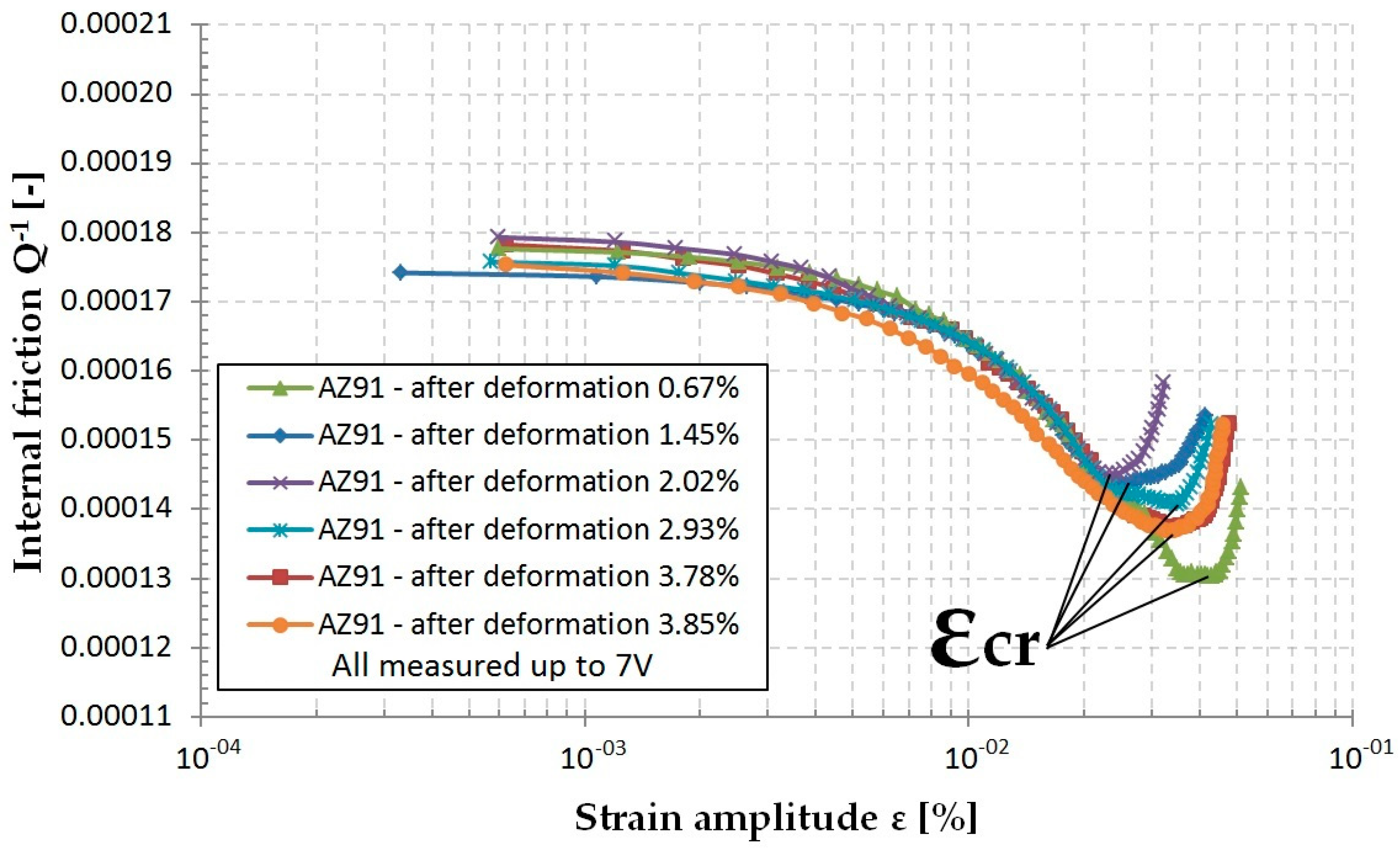
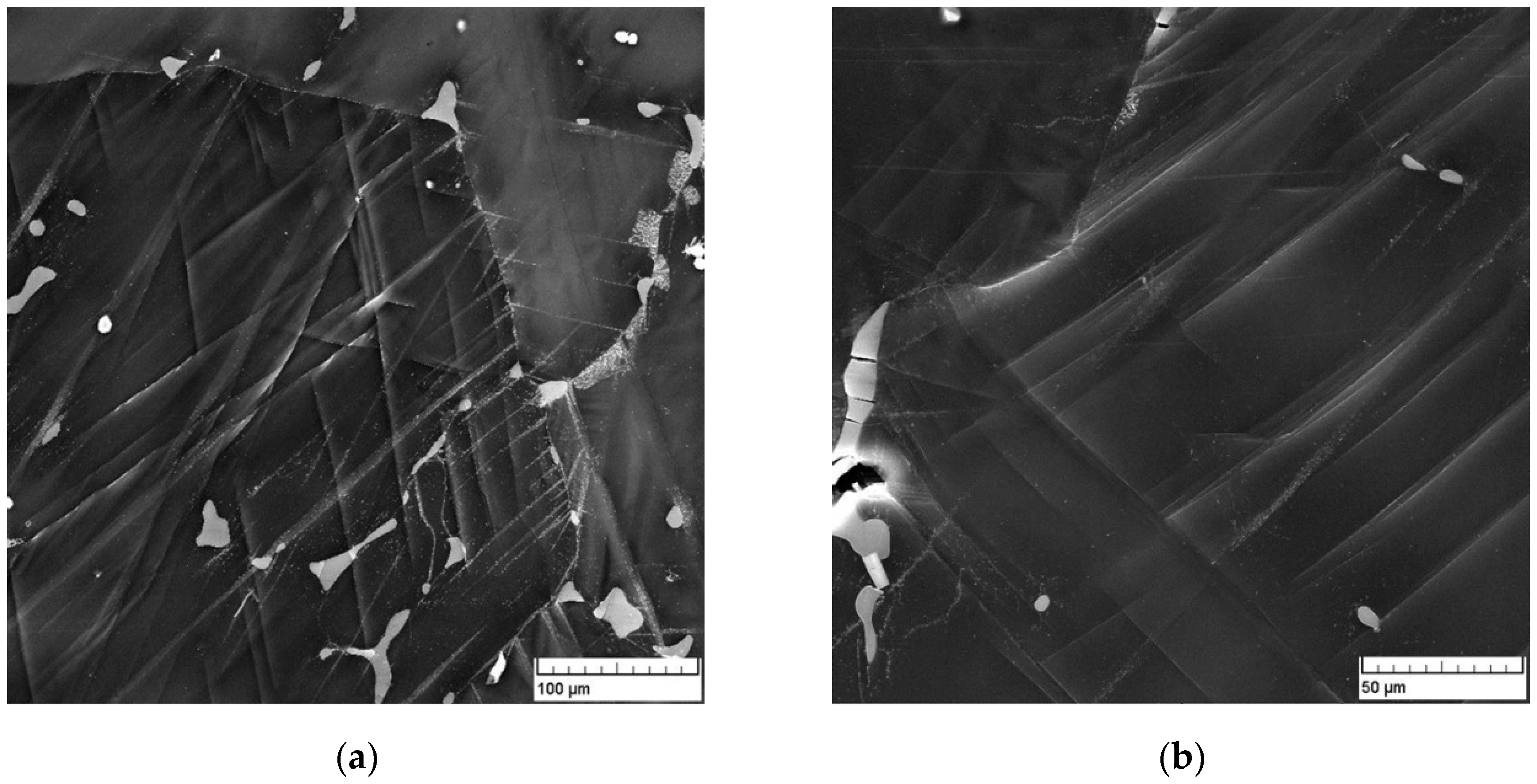
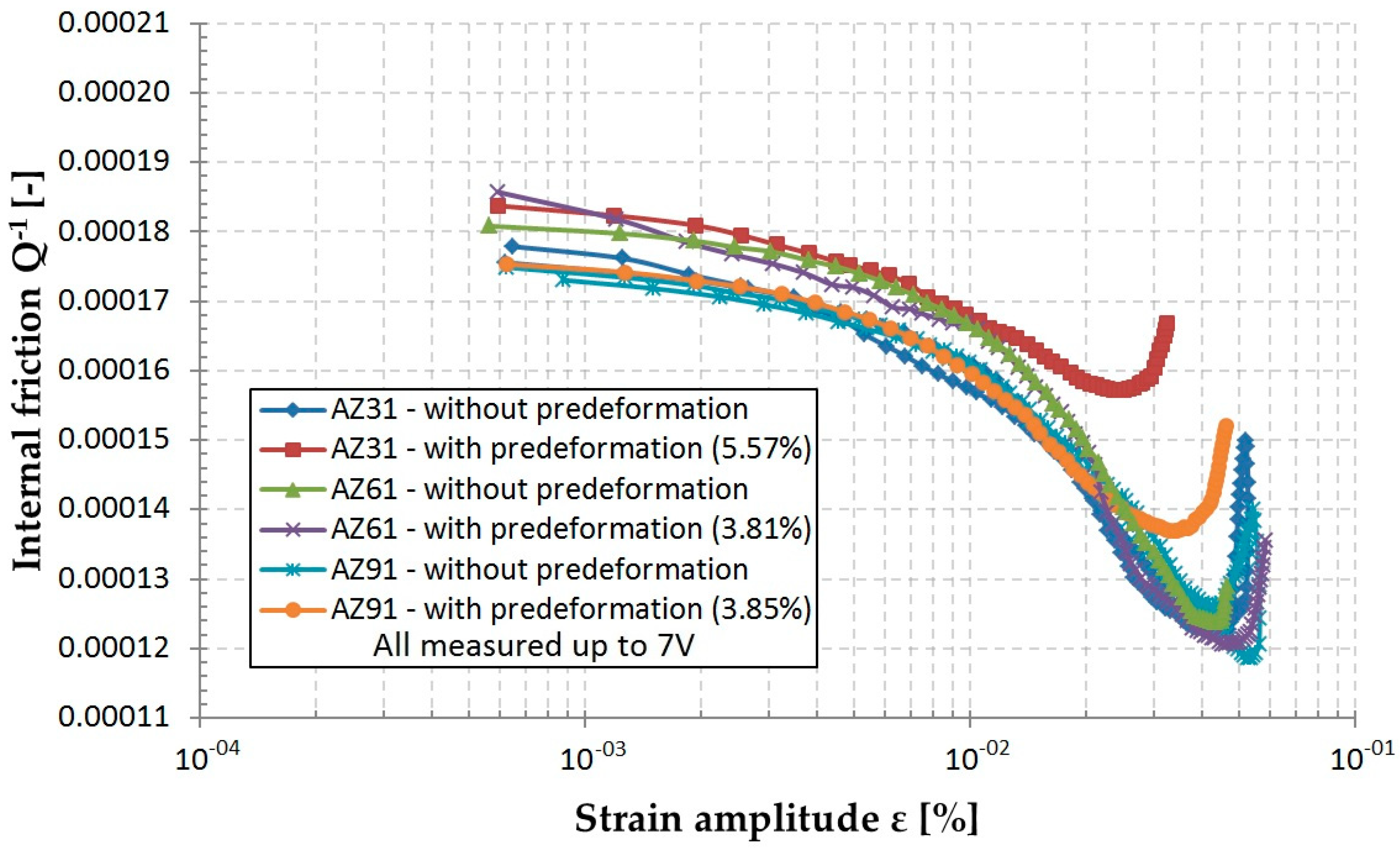

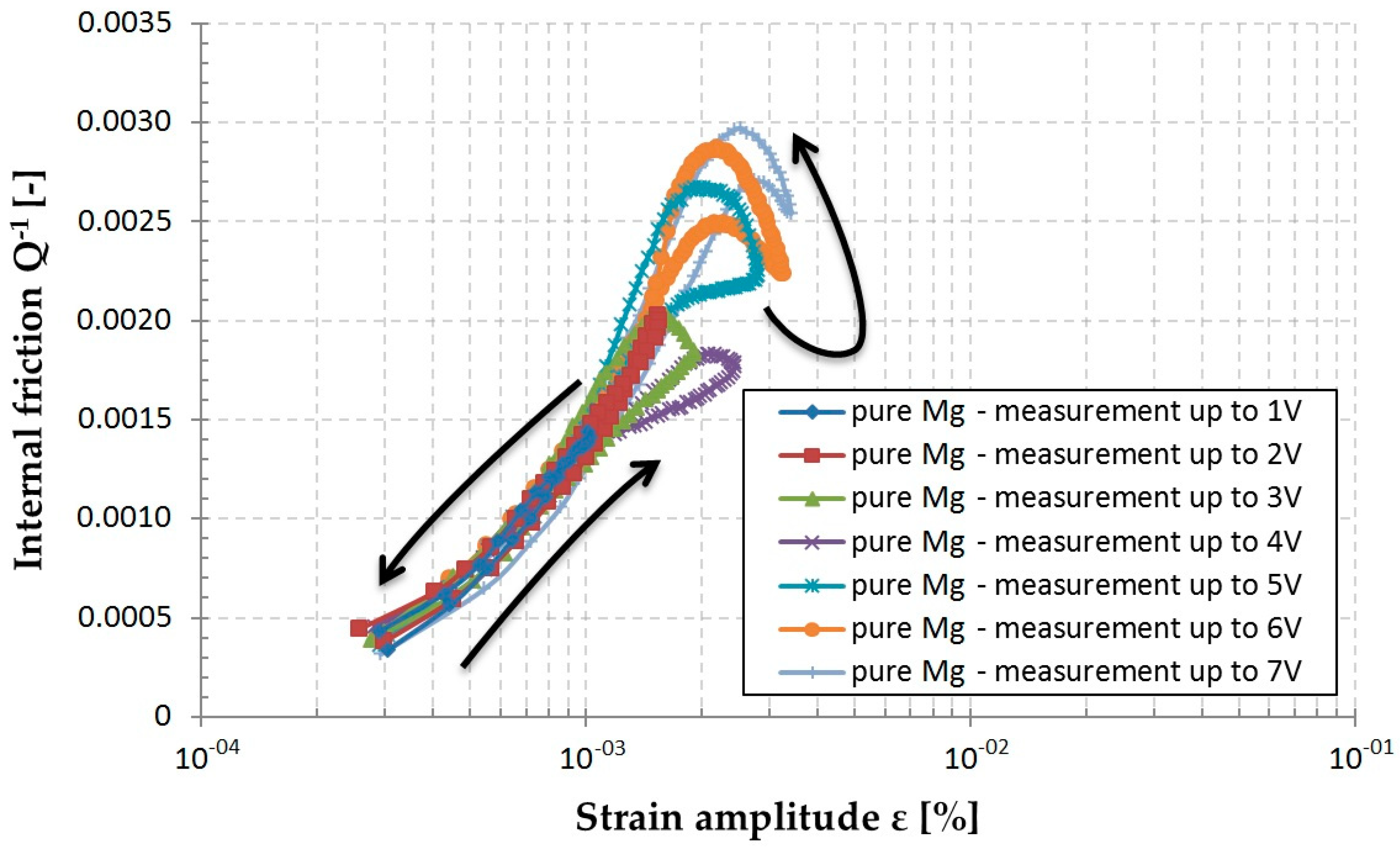
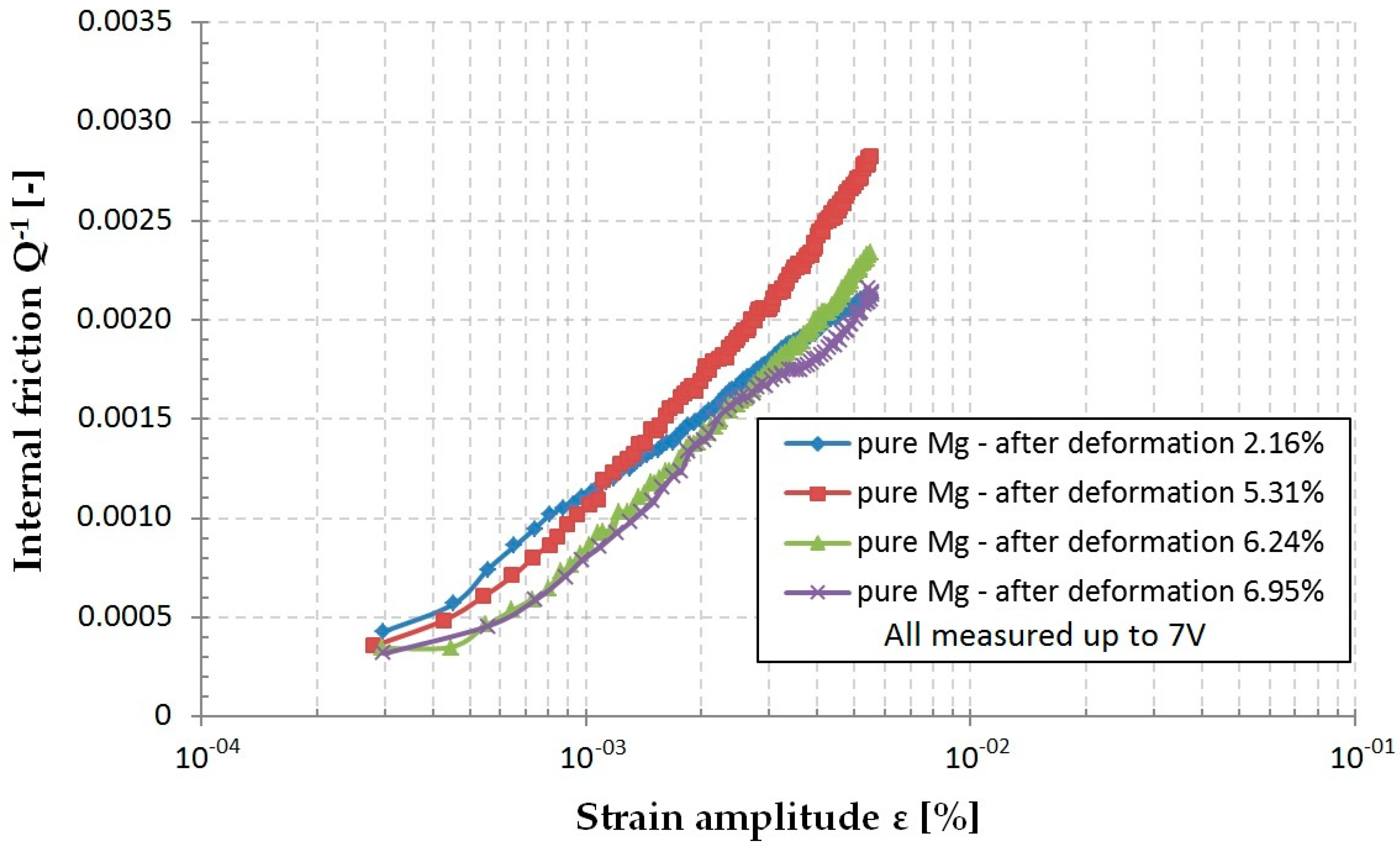
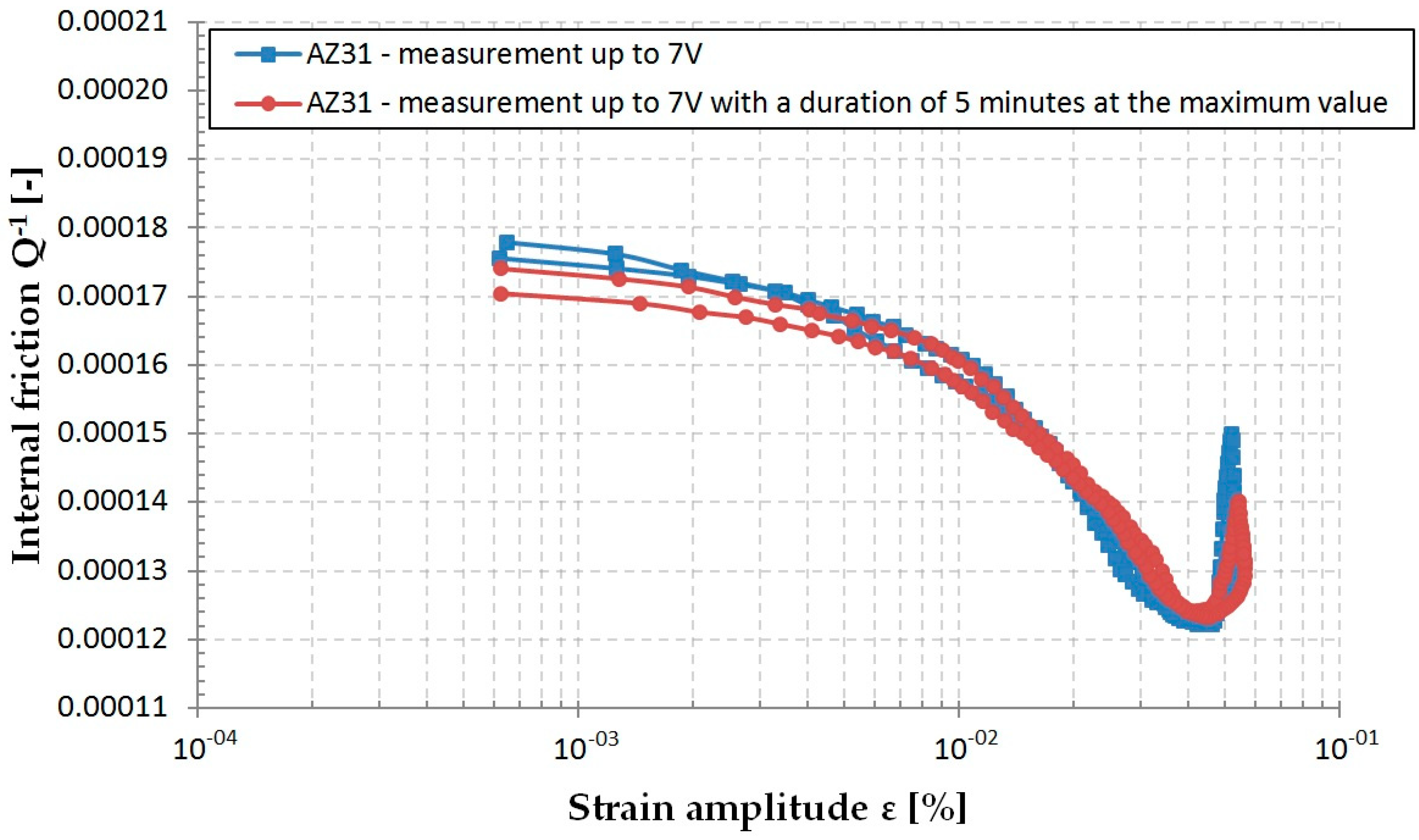
| Elements | Al | Zn | Mn | Si | Fe | P | Mg |
|---|---|---|---|---|---|---|---|
| AZ31 | 2.980 | 0.655 | 0.202 | 0.067 | 0.007 | 0.002 | balance |
| AZ61 | 6.880 | 1.200 | 0.229 | 0.079 | 0.007 | 0.005 | balance |
| AZ91 | 7.810 | 0.645 | 0.195 | 0.053 | 0.017 | 0.005 | balance |
© 2020 by the authors. Licensee MDPI, Basel, Switzerland. This article is an open access article distributed under the terms and conditions of the Creative Commons Attribution (CC BY) license (http://creativecommons.org/licenses/by/4.0/).
Share and Cite
Uhríčik, M.; Dresslerová, Z.; Palček, P.; Chalupová, M.; Trojanová, Z.; Hanusová, P. Amplitude Dependent Internal Friction in Strained Magnesium Alloys of AZ Series. Crystals 2020, 10, 608. https://doi.org/10.3390/cryst10070608
Uhríčik M, Dresslerová Z, Palček P, Chalupová M, Trojanová Z, Hanusová P. Amplitude Dependent Internal Friction in Strained Magnesium Alloys of AZ Series. Crystals. 2020; 10(7):608. https://doi.org/10.3390/cryst10070608
Chicago/Turabian StyleUhríčik, Milan, Zuzana Dresslerová, Peter Palček, Mária Chalupová, Zuzanka Trojanová, and Patrícia Hanusová. 2020. "Amplitude Dependent Internal Friction in Strained Magnesium Alloys of AZ Series" Crystals 10, no. 7: 608. https://doi.org/10.3390/cryst10070608
APA StyleUhríčik, M., Dresslerová, Z., Palček, P., Chalupová, M., Trojanová, Z., & Hanusová, P. (2020). Amplitude Dependent Internal Friction in Strained Magnesium Alloys of AZ Series. Crystals, 10(7), 608. https://doi.org/10.3390/cryst10070608





